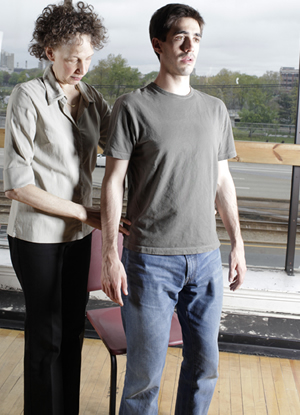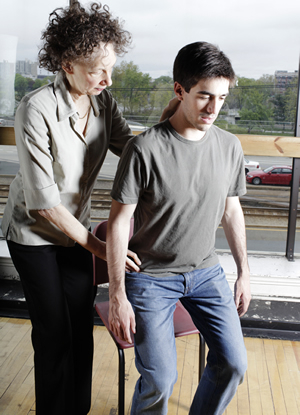
What Happens in a Lesson?
The Alexander Technique is usually taught through a series of one-on-one lessons on a weekly basis. In a lesson the student explores daily activities such as sitting, standing, and walking. The teacher uses a combination of verbal instruction and gentle hands-on guidance to lead the student to experience less effort and tension, in both stillness and motion. A lesson usually also includes a portion of working lying down on a table.
Other components of Betsy’s lessons:
Since Betsy’s training includes other methods that help achieve overall health, she integrates these methods into her Alexander work to optimize the student’s self-improvement process, making her work unique and highly effective.
Breathing Coordination
For many years Betsy worked closely with the late Carl Stough, breathing specialist. Carl was a choral conductor who was able to teach people of all ages to sing well very quickly. After working with singers and respiratory patients, he devised a system that he called “Breathing Coordination.” His principles of breathing coordination can help increase vital lung capacity, oxygenation and vocal range, and can decrease symptoms of stress and respiratory illness, including asthma and emphysema. Carl worked with people with respiratory illness as well as with singers and performers. Breathing Coordination allows the respiratory system to function at maximum efficiency with minimum effort.
Somatic Experiencing
Most of Betsy’s studies of trauma-overwhelming life events-were based on the work of Dr. Peter Levine, author of Waking the Tiger and Healing Trauma. While studying animals in the wild Dr. Levine observed that the animals had traumatic encounters all the time, but rarely had any lasting or debilitating effects. After many years of study he concluded that trauma is a biological process-not solely a mental process to be talked through. He saw that an instinctual response to trauma is a series of steps that take place physiologically, and all the steps need to be completed for recovery. When all the steps are not completed, the body is left with debilitating after-effects that take negative and destructive forms that can disrupt daily life. Dr. Levine developed a series of steps he called Somatic Experiencing that help track the sensations to move through the physiological steps. This allows the body to release the unresolved trauma that can hold one back from physical and mental health. Trauma lives in the body, not in the event. – Peter Levine
“When an investigation comes to be made, it will be found that every single thing we are doing in this work is exactly what is being done in Nature where the conditions are right, the difference being that we are learning to do it consciously.”





